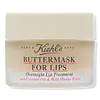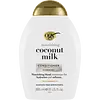What's inside
What's inside
 Key Ingredients
Key Ingredients

No key ingredients
 Benefits
Benefits

 Concerns
Concerns

 Ingredients Side-by-side
Ingredients Side-by-side

Bis-Diglyceryl Polyacyladipate-2
EmollientButyrospermum Parkii Butter
Skin ConditioningCocos Nucifera Oil
MaskingCera Alba
EmollientRicinus Communis Seed Oil
MaskingCandelilla Cera
EmollientTheobroma Cacao Seed Butter
EmollientJojoba Esters
EmollientSimmondsia Chinensis Seed Oil
EmollientOctyldodecanol
EmollientHelianthus Annuus Seed Cera
EmollientIrvingia Gabonensis Kernel Butter
Skin ConditioningWater
Skin ConditioningHydrogenated Coco-Glycerides
EmollientCaprylic/Capric Triglyceride
MaskingSalix Nigra Bark Extract
Skin ProtectingTocopherol
AntioxidantAcacia Decurrens Flower Cera
EmollientPolyglycerin-3
HumectantSorbic Acid
PreservativeVanilla Planifolia Fruit Extract
Skin ConditioningStevia Rebaudiana Leaf/Stem Extract
MaskingGlycine Soja Oil
EmollientCitric Acid
BufferingBis-Diglyceryl Polyacyladipate-2, Butyrospermum Parkii Butter, Cocos Nucifera Oil, Cera Alba, Ricinus Communis Seed Oil, Candelilla Cera, Theobroma Cacao Seed Butter, Jojoba Esters, Simmondsia Chinensis Seed Oil, Octyldodecanol, Helianthus Annuus Seed Cera, Irvingia Gabonensis Kernel Butter, Water, Hydrogenated Coco-Glycerides, Caprylic/Capric Triglyceride, Salix Nigra Bark Extract, Tocopherol, Acacia Decurrens Flower Cera, Polyglycerin-3, Sorbic Acid, Vanilla Planifolia Fruit Extract, Stevia Rebaudiana Leaf/Stem Extract, Glycine Soja Oil, Citric Acid
Water
Skin ConditioningCetearyl Alcohol
EmollientCetyl Alcohol
EmollientBehentrimonium Chloride
PreservativeCocos Nucifera Oil
MaskingCocos Nucifera Fruit Extract
EmollientAlbumen
Skin ConditioningHydrolyzed Milk Protein
Skin ConditioningGlycerin
HumectantPPG-3 Benzyl Ether Myristate
EmollientDimethicone
EmollientPolyquaternium-47
Skin ConditioningSteareth-20
CleansingDisodium EDTA
Isopropyl Alcohol
SolventCitric Acid
BufferingSodium Hydroxide
BufferingSodium Benzoate
MaskingParfum
MaskingWater, Cetearyl Alcohol, Cetyl Alcohol, Behentrimonium Chloride, Cocos Nucifera Oil, Cocos Nucifera Fruit Extract, Albumen, Hydrolyzed Milk Protein, Glycerin, PPG-3 Benzyl Ether Myristate, Dimethicone, Polyquaternium-47, Steareth-20, Disodium EDTA, Isopropyl Alcohol, Citric Acid, Sodium Hydroxide, Sodium Benzoate, Parfum
 Reviews
Reviews

Ingredients Explained
These ingredients are found in both products.
Ingredients higher up in an ingredient list are typically present in a larger amount.
Citric Acid is an alpha hydroxy acid (AHA) naturally found in citrus fruits like oranges, lemons, and limes.
Like other AHAs, citric acid can exfoliate skin by breaking down the bonds that hold dead skin cells together. This helps reveal smoother and brighter skin underneath.
However, this exfoliating effect only happens at high concentrations (20%) which can be hard to find in cosmetic products.
Due to this, citric acid is usually included in small amounts as a pH adjuster. This helps keep products slightly more acidic and compatible with skin's natural pH.
In skincare formulas, citric acid can:
While it can provide some skin benefits, research shows lactic acid and glycolic acid are generally more effective and less irritating exfoliants.
Most citric acid used in skincare today is made by fermenting sugars (usually from molasses). This synthetic version is identical to the natural citrus form but easier to stabilize and use in formulations.
Read more about some other popular AHA's here:
Learn more about Citric AcidCocos Nucifera Oil is obtained from the kernels of the coconut fruit. In other words, this is coconut oil.
Coconut Oil is rich in fatty acids with lauric acid making up the majority of these. It also contains linoleic acid. Due to this high fatty acid content, coconut oil helps trap moisture and soften skin.
Despite being antibacterial, coconut oil may not be great for acne-prone skin. It is comedogenic and may clog pores. This ingredient may not be safe for malassezia or fungal acne.
Note: Coconut Oil should not replace your sunscreen for UV protection. Studies show it only blocks about 20% of UV.
This oil is non-volatile and has a light scent.
The term 'fragrance' is not regulated in many countries. In many cases, it is up to the brand to define this term. For instance, many brands choose to label themselves as "fragrance-free" because they are not using synthetic fragrances. However, their products may still contain ingredients such as essential oils that are considered a fragrance.
Learn more about Cocos Nucifera OilWater. It's the most common cosmetic ingredient of all. You'll usually see it at the top of ingredient lists, meaning that it makes up the largest part of the product.
So why is it so popular? Water most often acts as a solvent - this means that it helps dissolve other ingredients into the formulation.
You'll also recognize water as that liquid we all need to stay alive. If you see this, drink a glass of water. Stay hydrated!
Learn more about Water